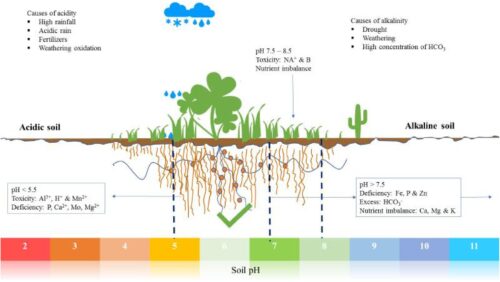Plants can not grow in acidic soil due to its excessive awareness of hydrogen ions, which influences nutrient availability and disrupts essential biological strategies. In acidic soil, the pH level is beneath 7, indicating a higher concentration of hydrogen ions.
This acidic surroundings alters the chemical and physical houses of the soil, making it improper for plant boom. The excessive attention of hydrogen ions interferes with the supply of vital nutrients, together with nitrogen, phosphorus, and potassium, which flora require for proper increase and development.
Additionally, acidic soil also can have an effect on the hobby of beneficial soil microorganisms that resource in nutrient absorption and decomposition of natural rely. As a result, flowers battle to obtain the necessary nutrients and can’t carry out crucial biological procedures, ultimately resulting in stunted growth and terrible general health in acidic soil situations.

Credit: morningchores.Com
Effects Of Acidic Soil On Plant Growth
When it involves plant growth, the pH degree of the soil plays a massive position. The acidity or alkalinity of the soil, called pH, may have a direct effect at the improvement and fitness of flowers. In this section, we are able to discover the effects of acidic soil on plant boom, focusing on the effect of low pH on nutrient availability and aluminum toxicity main to root growth inhibition.
Impact Of Low Ph On Nutrient Availability
The pH degree of the soil affects the supply of important vitamins for plant boom. In acidic soil, positive vitamins consisting of nitrogen, phosphorus, and potassium come to be much less reachable to flora because of chemical reactions inside the soil, making it hard for vegetation to obtain the vital nourishment for their development.
Aluminum Toxicity And Root Growth Inhibition
Acidic soil also can result in aluminum toxicity, which negatively impacts root boom. The low pH levels trigger the discharge of aluminum ions, that may inhibit root elongation and impede the plant’s potential to soak up important water and nutrients. This can bring about stunted boom and usual terrible fitness of the plants.
Root Causes Of Soil Acidity
Soil acidity hinders plant increase due to low pH stages preventing nutrient uptake. Root causes of soil acidity include acid rain, immoderate use of fertilizers, and leaching minerals. These elements disrupt soil balance, affecting plant health and development.
Natural Acidification Processes
Soil acidity is generally caused by natural tactics that occur over the years. One of the root reasons of soil acidity is the breakdown of natural matter, such as fallen leaves and decomposing plants. As these natural materials smash down, they release acids into the soil. Additionally, the weathering of rocks and minerals also can contribute to soil acidity. Certain sorts of rocks, along with granite, include minerals that can produce acidic soil situations after they damage down. These herbal acidification tactics can gradually lower the pH degree of the soil, making it wrong for many flora to thrive.
Human-triggered Acidification
In addition to herbal tactics, human sports also can make contributions to soil acidity. Agricultural practices, which includes the overuse of fertilizers and fallacious soil management, can bring about soil acidification. When immoderate amounts of positive fertilizers, like ammonium-based totally fertilizers, are applied to the soil, they can launch acids during the breakdown process. This can decrease the pH degree of the soil and create an acidic environment. Furthermore, pollutants, which include business emissions and acid rain, can deposit acidic compounds onto the soil floor, similarly exacerbating soil acidity. These human-brought about acidification procedures will have a unfavourable effect on plant increase and productiveness.
Conclusion
Overall, soil acidity can be attributed to each herbal and human-brought on elements. The breakdown of organic matter and the weathering of rocks make a contribution to natural acidification, even as agricultural practices and pollutants make a contribution to human-triggered acidification. Understanding the root causes of soil acidity is essential for enforcing proper soil control strategies and figuring out suitable plants that may thrive in acidic situations. By addressing those factors, it is viable to relieve soil acidity and create an surroundings conducive to healthy plant boom.
Adaptations Of Acid-tolerant Plants
Plants warfare to develop in acidic soil due to the detrimental consequences on their root development and nutrient uptake. However, a few acid-tolerant flowers have adapted to thrive in such situations by using growing mechanisms to neutralize the acidity and correctly take in crucial nutrients, allowing them to flourish where other flora conflict.
Plants have a extremely good capability to conform to their surroundings, and acid-tolerant plant life are no exception. These plant life have developed particular mechanisms to address the demanding situations posed through acidic soil. By knowledge those adaptations, we can gain valuable insights into the complexities of plant survival in harsh conditions.
Aluminum Tolerance Mechanisms
One principal mission that acid-tolerant flora face is the presence of toxic aluminum ions, that are released in acidic soil. These ions can seriously inhibit root boom and nutrient uptake. To counteract this, acid-tolerant flowers have developed precise aluminum tolerance mechanisms. They produce natural acids, consisting of citric acid, that bind with aluminum ions and render them innocent. This allows flora to continue to soak up vital nutrients, making sure top-quality growth even in acidic environments.
Ph Regulation Strategies
Maintaining an most useful pH degree is important for any plant’s survival and boom. Acid-tolerant flowers employ numerous strategies to adjust pH in acidic soil. One such approach is root exudation, wherein vegetation launch a number of compounds into the soil, together with natural acids and enzymes. These materials actively lower the pH inside the immediate root quarter, developing a greater appropriate surroundings for the plant. Another pH law method includes the manufacturing of pH buffers, which help to hold the encompassing soil pH inside a suitable range. These buffering dealers save you pH fluctuations because of the acidic nature of the soil, presenting a solid circumstance for plant boom. Overall, acid-tolerant flowers show off incredible diversifications that allow them to thrive in acidic soil conditions. From aluminum tolerance mechanisms to pH law techniques, these vegetation have evolved specific mechanisms to conquer the challenges posed by way of acidic environments. Understanding those adaptations no longer best sheds mild at the resilience of flowers but also gives treasured insights for agriculture and environmental control.
Improving Soil Acidity For Plant Growth
Plants struggle to grow in acidic soil because of its excessive degrees of hydrogen ions, which preclude nutrient availability. By enhancing soil acidity, we will create a greater favorable environment for plant growth, ensuring they receive the vital vitamins for most advantageous development.
Improving Soil Acidity for Plant Growth Soil acidity can substantially affect the boom of plants. Lime Application for pH Adjustment and Organic Matter Addition for Buffering are powerful methods for addressing this difficulty.
Lime Application For Ph Adjustment
Lime, primarily in the shape of calcium carbonate, is a extensively used agricultural soil change. It raises the pH of acidic soil, making it less acidic and extra neutral. Applying lime can help to unlock essential nutrients for plant boom, which include phosphorus and potassium. This adjustment aids in selling healthier root development within plant life, main to improved nutrient uptake and progressed ordinary increase.
Organic Matter Addition For Buffering
Improving soil acidity with natural depend can provide a herbal buffering impact, supporting to stabilize pH degrees. Organic materials like compost, manure, and plant residues act as a buffer in opposition to rapid pH fluctuations. By incorporating those substances into the soil, the pH degree turns into more resilient to versions in acidity, imparting a strong and conducive environment for plant growth. By imposing these methods, it’s miles feasible to transform acidic soil into a hospitable environment for numerous plant species to thrive.
Case Studies And Practical Applications
Successful Farming Practices In Acidic Soils
Implement soil checking out to decide nutrient deficiencies. Use lime to elevate pH ranges. Choose acid-tolerant plants like potatoes and blueberries. Consider adding organic be counted or compost. Monitor soil pH regularly.
Research On Acidic Soil Reclamation
Scientists are investigating the use of biochar to neutralize acidity. Studies show capability for ameliorating low pH ranges. Promising results in restoring soil fitness. Future packages in agricultural settings.

Credit: www.Frontiersin.Org

Frequently Asked Questions For Why Can’t Plants Grow In Acidic Soil?
Why Do Plants Not Grow Well In Acidic Soil?
Plants battle to grow in acidic soil because of low nutrient availability and improved toxicity ranges.
How Does Acidic Soil Affect Plant Growth?
Acidic soil influences plant growth by means of reducing nutrient availability, hindering root development, and inflicting toxicity in some flora. It also disrupts the soil’s microbial hobby, impacting the breakdown of natural depend. As a end result, flora may show off stunted growth, yellowing leaves, and basic negative fitness.
Why Is Acid Bad For Plant Growth?
Acid hinders nutrient absorption in vegetation, affecting boom and fitness negatively. This can cause wilting and stunted development.
What Happens To Plants In Soil If A Ph Is Too High?
High soil pH can lead to nutrient deficiencies in plants, affecting their growth and fitness. Alkaline conditions prevent nutrient uptake, resulting in stunted growth and yellowing leaves. It can also disrupt the balance of microorganisms inside the soil, further impacting plant health.
Conclusion
Understanding the impact of acidic soil on plant increase is crucial for a hit gardening. By preserving the pH balance, including organic matter, and choosing suitable vegetation, you can counteract the results of acidity. With these insights, you may nurture a more healthy, thriving lawn to experience the beauty of nature.
